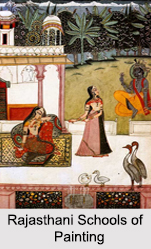 Rajasthani painting developed and increased in the stately courts of Rajputana in India. Each Rajputana empire developed a different method but with positive common characteristics. Rajput paintings represent a number of themes, proceedings of epics like the Ramayana.
Rajasthani painting developed and increased in the stately courts of Rajputana in India. Each Rajputana empire developed a different method but with positive common characteristics. Rajput paintings represent a number of themes, proceedings of epics like the Ramayana.
A number of Hindu Rajput kingdoms like Bikaner, Jodhpur, Bundi, Kota and Mewar patronised Indian art in Rajasthan. Many were deeply influenced by the Mughal style of painting while some deviated from the archetypal style of Mughal miniature. Rajasthani School of painting artists attached to the courts of the Mughals. Rajasthani schools of painting remained entirely with its sheer grandeur illustrates a particular school of art which once stood apart in terms of both subject-matter and conception from the exactly the then contemporary work of the traditional in its magical illustration of the Indian epics and Indian literature. The development of the Rajasthani schools of painting is the pictorial counterpart of the vernacular literature of India. Rajasthani schools of painting may be presented as an amalgamation of folk art with hieratic and classic traditions.
History of Rajasthani Schools of Painting
The influential way of Rajasthani School of painting towards the end of the 16th century for the first time is seen in early on Mewar paintings. Later numerous states of Rajasthan had developed their own character styles of painting, the most famous amongst them were Kota, Bundi, Bikaner, Kishangarh, Mewar and Jaipur.
It was during the rule of Jagat Singh of Mewar in the early 17th century the painter Sahib Din prospered. His studio then stood as the epithet of brilliant art works including the Ramayana and the Ragamala painting. The conflict of Mewar with the Mughals prompted Sahib Din to adopt a whole different format from the Mughal miniature.
Features of Rajasthani Schools of Painting
Previously Rajasthani painting came into individual, it advancement fast under local painters and the apparent feature in them was the Mughal style influence, except their art was very different in character and viewpoint.
The colours were removed from convinced minerals, fix sources, conch shells and were even copied by dispensation valuable stones. Gold and silver were used. The training of desired colours was a long-lasting process, sometimes taking weeks. Brushes used were very well. The wide eyes, with black outlining typically recall the pre-Mughal secular text "Caurapanchasika" style of painting. These styles characteristically initiated a whole new facet in the Rajasthani School of painting which are borrowed from the palm leaf manuscripts. However, the Ragmala Paintings were indeed done in rectangular style. The multiplicity and significance of Hindu deities as the subject material of Rajput painting marked one more departure from Mughal art.
Types of Rajasthani Schools of Painting
The Rajasthani Schools of Painting can be divided into some schools which are spread across different geographic and political areas of the state. They may look alike at first quick look but a nearer look displays different restrained differences between these schools. Also, the major schools are further divided into many smaller sub-schools. The chief schools are as follows:
•Marwar: Marwar is the chief area in Rajasthan, casing the Thar Desert area that contains chief centres of art for example Jodhpur, Kishangarh, Bikaner and Jaisalmer. Miniature paintings of this school are also very famous. As these were chief empires, their art reproduces tales of the imperial history, clash scenes and hunting scenes as well.
•Mewar: Mewar is the South Central Region of Rajasthan middle of Udaipur. The Mewar schools are perhaps the oldest and most significant. Some vital secondary schools here comprise Chavand, Nathdwara and Devgarh. Particularly notable is the one at Nathdwara, which is a small town known for the temple of Srinathji.
•Dhundar: The region around Jaipur is called Dhundar. However this includes a huge region and also covers the Shekhwati region of Northern Rajasthan which is still recognized all over the world for their "Havelis" with lively wall paintings. Another important centre of this school is Alwar.
•Hadoti: Hadoti area is the South Eastern area of Rajasthan, centred largely on the cities of Bundi, Kota and Jhalawar. It drew from Mewar School but vividly combined elements of Mughal art with it also.
•Kangra and Kullu: The Kangra and Kullu schools of art have also influenced Rajput paintings. Jitendra Sahoo is a famed artist of Rajput painting.
It is interesting that in Rajasthan, the art of wall painting received a new lease of life with the painting of the havelis and palaces which was then in trend in the early 18th century. Among the Rajasthani schools of painting; the school of Kota, Bundi and Bikaner adapted some of the characteristic conventions of the Mughal miniature. The much followed depictions of these murals are battles and the processions and folk deities. Folk style art was main in depicting the art. The murals in the palaces of Bikaner, Udaipur and Bundi are still reckoned as the classical works of art and artistry of Rajasthani School of painting which has so delicately redefined the art and artistry of India.



















